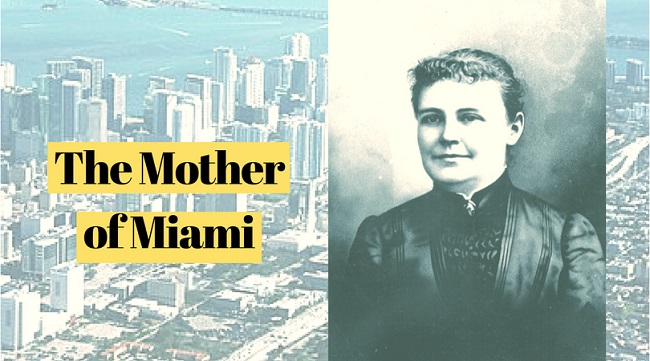It’s widely accepted that she’s the only woman in the United States to have founded a major American city.
A bronze statue of Julia Tuttle, standing at ten feet tall, is on display in Bayfront Park in Miami. She’s got oranges in one hand and a branch with little blooms in the other.
Tuttle is the first woman in American history to have founded a significant city, and she has held the title of “Mother of Miami” for decades. South Florida residents have been informed for decades that she is solely responsible for establishing the city of Miami.

Listener Logan Jaffe remarked, “She was the one who got Henry Flagler to build a railroad all the way down to Miami.”
As we searched for the solution, we stumbled onto another another puzzlement. Julia Tuttle is widely regarded as “Miami’s mom.” But suppose it’s not quite that easy.
As it turns out, 123 years later, another mother of Miami may be able to claim the title “Mother of Miami” alongside Julia Tuttle.
“Truly, [Tuttle] was important. There’s no way around it “Cesar Becerra, a historian from the southern part of Florida, made this statement. However, it’s important to consider whether or not a co-mother label is warranted, and I’ve come to the conclusion that it is.
A Warm Welcome To Miami
Back in 1875, Tuttle got his first taste of the wilds of southeast Florida. She was a young mother and wife when she made the trip from Cleveland, Ohio to the area now known as Miami Shores to see her ageing farming parents.
Florida’s subtropical charms won her over, and she swore to settle down there one day.
Tuttle, according to History Miami’s resident historian Paul George, was one of just nine people to settle at the mouth of the Miami River in 1891. And, as “Miami, The Magic Metropolis and The Forgotten Frontier” author Arva Moore Parks claims, her goal was to “create this the greatest city in the southland.”
She wrote to two entrepreneurs, Henry Flagler in the north and Henry Plant on the west coast, who were constructing railroads across Florida, and offered them land in exchange for bringing their lines to Biscayne Bay.
Tuttle received a definitive rejection after writing to Plant eight times.
According to Seth Bramson, an adjunct professor and historian in residence at Barry University: “He replied and he said, ‘My dear madam, I have no intention of extending my railroad 160 miles across trackless wilderness to please your ego.’
That meant Flagler was Miami’s last best chance at becoming the magnificent metropolis she had envisioned for it.
Hunting Flagger
When Tuttle heard the bad news from Plant, Flagler’s Florida East Coast Railroad was already more than sixty-five miles north of Miami. Flagler never planned to build his line into the swamp.
Nonetheless, Tuttle wasn’t the only one who lobbied Flagler to make the journey south. It is also said that Mary Brickell, Tuttle’s neighbour on the other side of the Miami River, was in touch with the railroad tycoon. In exchange for his constructing a town south of West Palm, she had provided him a vast swath of her land on which to lay track between Coconut Grove and that city. At least not just now, he had no interest.
Next, Florida experienced a string of freezes from December 1894 through February 1895. Oranges turned black and mature orange trees were damaged as temperatures dropped below 30 degrees. The first blast of frigid air lasted for only six weeks before it was followed by another equally harsh weather episode. It looked as if the entire orange-producing business had been wiped out.
The time had come, as Tuttle had been told by Paul George. Tuttle notified Flagler via telegram about the change in weather. She told him that Miami had escaped the cold weather’s effects and invited him to come check it out.
Flagler had two men travel from St. Augustine to Miami via train and boat, where they were met by Tuttle and the Brickell family. The guys gathered a box of citrus tree branches wrapped in cotton on Flagler’s behalf and brought them back to the north.
Flagler then made another attempt to contact the households. He was prepared to accept Brickell’s and Tuttle’s proposals now.
The Women in Charge in Miami
On April 15, 1896, the first train pulled into Miami. The city was officially established on July 28, 1896, three months later. Soon after, the “Mother of Miami” legend began to circulate.
The answer is yes; Julia Tuttle was the impetus. Indeed,” insisted Seth Bramson. She was the one that wired Mr. Flagler as soon as the temperatures dropped. Yes, she was the one who penned that letter.
Is it Possible that Miami was Raised by a Mother and a Father?
Mary and William started their property on the Miami River in 1871, twenty years before Tuttle settled there. The family established a trading station and post office on the southern bank of the Miami River to facilitate trade with local Native American communities in the Everglades.
Now, Flagler required Tuttle’s and the Brickells’ land so that he could build a rail link to Key West. He always intended for it to be the case. True, Miami wasn’t really a major city back then.
Moore Parks claims that Flagler negotiated an agreement to use land held by both women in exchange for building the train through their properties.
Moore Parks credited Julia Tuttle with facilitating Flagler’s relocation to Miami by having Mary Brickell make a land donation in addition to the original one from Flagler. A lot of that went into convincing him to show there.


















